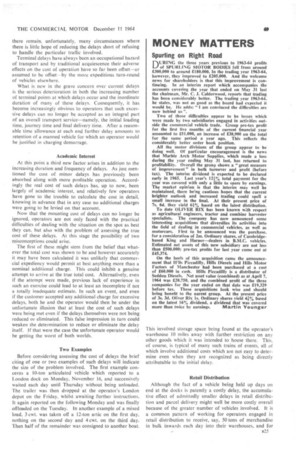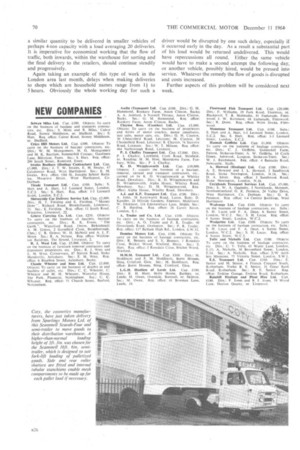The Cumulative Effect of Dock Delays
Page 70

Page 71

Page 72

If you've noticed an error in this article please click here to report it so we can fix it.
WRY comments by road transport operators may well have followed last week's announcement that yet another Government committee has been set up to see what can be done about dock delays—not only in the long run, but immediately. Following hard on the heels of the Devlin inquiry now in the second stage of its deliberations, this new committee of senior civil servants is headed by the Permanent Secretary of the Ministry of Transport. All concerned can only hope that it will prove more effective than the many previous inquiries.
Meanwhile, road transport operators are having to face the brunt of worsening delays, not only at the docks, but at a high proportion of other terminal points at which they collect and deliver their traffic. Dossiers of dock delays have been widely publicized recently in national newspapers, and with threats of dock strikes—official or unofficial—such publicity is undoubtedly topical. Yet for road transport operators daily experiencing such delays it must make sour reading when for every example quoted they could recount similar delays or worse to their own vehicles.
Nation-wide Publicity
Nevertheless, such nation-wide publicity as to the extent of these delays highlights for all concerned the very real problem which road transport operators are now daily having to face. Inevitably any solution—or more realistically partial .solution—of this problem remains for the operator himself to evolve as best he can, at least for the time being.
In providing a transport service a road transport operator is invariably an intermediary between suppliers, consumers and other agencies at transhipment and terminal points. So positive remedial action to deal with the root of the problem is seldom within his authority to take. Indeed, the disturbing factor in this whole problem of excessive delays at terminal points is that the situation is not only deteriorating, but that for reasons of political or industrial expediency it seems unlikely that any fundamental improvement can be expected in the immediate future. Paradoxically any success that may attend the latest Governmental exhortations to higher productivity and exports could well aggravate terminal delays—at least in the immediate future. Meanwhile, current dock delays are such that operators must now presumably accept as a relative improvement the recently announced permission to allow their vehicles reserved priority in tomorrow's queue if today's wait has been of no avail.
Alarming Reading Cataloguing of terminal delays makes alarming reading, but in isolation such an exercise does nothing to reduce, still less resolve, the effects of these delays on the economical use of vehicles—whether those of professional hauliers or ancillary users. The citing of such instances must have a specific objective if any useful purpose is to be served.
An immediate purpose could be to see whether local action at the point of delay could prove effective. Alternatively, where regular collection and deliveries are concerned, the very repetitiveness of particular delays could be a pointer to the cause and possible solution. For experienced operators, however, these are first steps which will already have been examined long ago and any shortcomings thereby revealed already remedied.
Measures involving long-term plans such as articulation, mechanical loading methods, or the employment of vehicles with specialized bodywork so as to reduce terminal times in a scientific manner, will no doubt also have been considered, often in consultation with the customers concerned.
Daily Duties
All such possible action is part and parcel of a transport manager's daily duties and responsibilities, with each and every opportunity for reducing such delays already examined. In fact, the very regularity and thoroughness with which this is done might engender that resigned attitude of "We've tried all this before Such an attitude could inhibit both the will and perception to recognize new factors as and when they arise. As with other aspects of transport—especially on a large scale—the possibility of repetitive, or near-repetitive operation leading to a resigned frame of mind is an attitude to be guarded against.
But when all steps have been taken by the operator within his sphere of authority to cut down terminal delays, there remain, unfortunately, many circumstances where there is little hope of reducing the delays short of refusing to handle the particular traffic involved.
Terminal delays have always been an occupational hazard of transport and by traditional acquiescence their adverse effects on the cost of operation have so far been offset—or assumed to be offset—by the more expeditious turn-round of vehicles elsewhere, What is new in the grave concern over current delays is the serious deterioration in both the increasing number of terminal points at which delays occur and the inordinate duration of many of these delays. Consequently, it has become increasingly obvious to operators that such excessive delays can no longer be accepted as an integral part of an overall transport service—namely, the initial loading time, journey time and final delivery time. After a reasonable time allowance at each end further delay amounts to retention of a manned vehicle for which an operator would be justified in charging demurrage.
Academic Interest At this point a third new factor arises in addition to the increasing duration and frequency of delays. As just mentioned the cost of minor delays has previously been absorbed along with more profitable operation. Accordingly the real cost of such delays has, up to now, been largely of academic interest, and relatively few operators have gone to the trouble to calculate the cost in detail, knowing in advance that in any case no additional charges were going to be levied on that account.
Now that the mounting cost of delays can no longer be ignored, operators are not only faced with the practical difficulties of dealing with the situation on the spot as best they can, but also with the problem of assessing the true cost of these delays. At this stage the possibility of two misconceptions could arise.
The first of these might stern from the belief that whatever the total cost was shown to be and however accurately it may have been calculated it was unlikely that commercial expediency would permit at best anything more than a nominal additional charge. This could inhibit a genuine attempt to arrive at the true total cost. Alternatively, even if the attempt were made, previous lack of experience in such an exercise could lead to at least an incomplete if not a totally inadequate estimate. In such an event, and even if the customer accepted any additional charge for excessive delays, both he and the operator would then be under the unfortunate illusion that at least the cost of such delays were being met even if the delays themselves were not being reduced or eliminated. This false impression in turn could weaken the determination to reduce or eliminate the delay itself. If that were the case the unfortunate operator would be getting the worst of both worlds.
Two Examples Before considering assessing the cost of delays the brief citing of one or two examples of such delays will indicate the size of the problem involved. The first example concerns a 10-ton articulated vehicle which reported to a London dock on Monday, November 16, and successively waited each day until Thursday without being unloaded. The trailer was then dropped at the operator's London depot on the Friday, whilst awaiting further instructions. It again reported on the following Monday and was finally offloaded on the Tuesday. In another example of a mixed load, 3 cwt. was taken off a 12-ton artic on the first day, nothing on the second day and 4 cwt. on the third day. Then half of the remainder was consigned to another boat. This involved storage space being found at the operator's warehouse 10 miles away with further restriction on any other goods which it was intended to house there. This, of course, is typical of many such trains of events, all of
which involve additional costs which are not easy to determine even when they are recognized as being directly attributable to the initial delay.
Retail Distribution
Although the fact of a vehicle being held up days on end at the docks is patently a costly delay, the accumulative effect of admittedly smaller delays in retail distribution and parcel delivery might well be more costly overall because of the greater number of vehicles involved. It is a common pattern of working for operators engaged in retail distribution to receive, say, 50 tons of merchandise
in bulk inwards each day into their warehouses, and for a similar quantity to be delivered in smaller vehicles of perhaps 4-ton capacity with a load averaging 20 deliveries. It is imperative for economical working that the flow of traffic, both inwards, within the warehouse for sorting and the final delivery to the retailers, should continue steadily and progressively.
Again taking an example of this type of work in the London area last month, delays when making deliveries to shops which are household names range from 11 to 5 hours. Obviously the whole working day for such a driver would be disrupted by one such delay, especially if it occurred early in the day. As a result a substantial part of his load would be returned undelivered. This would have repercussions all round. Either the same vehicle would have to make a second attempt the following day, or another vehicle, possibly hired, would be pressed into service. Whatever the remedy the flow of goods is disrupted and costs increased.
Further aspects of this problem will be considered next week.
















































































































